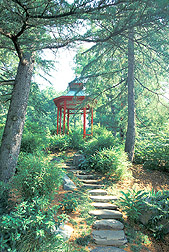This page has been archived and is being provided for reference purposes only. The page is no longer being updated, and therefore, links on the page may be invalid.
|
Read the magazine story to find out more. |
U.S. National Arboretum--Still Beautiful at 75By Alfredo FloresMay 29, 2002 The U.S. National Arboretum, celebrating its 75th anniversary this year, has some impressive numbers to show for three-quarters of a century in the nation’s capital. Each year, more than half a million visitors from all parts of the world come to view the 9,000 different kinds of plants growing inside the arboretum’s 446 acres in Washington, D.C., showing that the arboretum is a valuable facility for both research and public education. More than 250,000 visit “virtually,” through the World Wide Web, to ask questions about the arboretum and gardening. Scientists in the arboretum’s Floral and Nursery Plants Research Unit use classical breeding, genetic engineering, molecular biology, entomology and virology to solve horticultural problems encountered by industry professionals as well as by recreational gardeners. Topping the list of industry needs is finding hardy plants that are resistant to diseases and pests. Researchers recently used a technique called polymerase chain reaction to confirm the presence of plum pox virus, detect different strains and assess their potential damage to host plants. This virus is of great concern to the stone fruit industry that includes plums, peaches, apricots and nectarines. Developing elm trees resistant to Dutch elm disease and preserving the historic Yoshino cherry trees that ring Washington’s Tidal Basin are two of the arboretum’s best-known recent accomplishments. But over the course of its history, the arboretum and the Agricultural Research Service, which administers the arboretum, have introduced more than 665 new plant releases and have secured 13 patents and two Environmental Protection Agency biopesticide registrations. A more in-depth article about the arboretum appears in the May issue of Agricultural Research magazine. ARS is the U.S. Department of Agriculture’s primary scientific research agency. |

